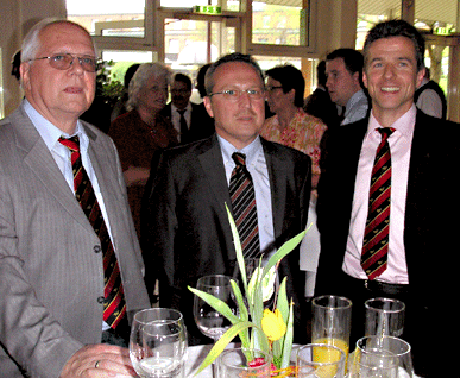Fraport Cargo Club Flies
Sea-Air
 Most
Happy Fella at ACD Happy Hour yesterday at Frankfurt Air Cargo Club is
Willy Rieth in the center and members Rainer Beck, an agent, representing
Geis SDV (left) and Christian Thiele, Cargo Business Development Manager
Emirates Sky Cargo (right). Most
Happy Fella at ACD Happy Hour yesterday at Frankfurt Air Cargo Club is
Willy Rieth in the center and members Rainer Beck, an agent, representing
Geis SDV (left) and Christian Thiele, Cargo Business Development Manager
Emirates Sky Cargo (right).
Willy
Rieth, managing director of Sea-Air Transport “Albatros” (S.A.T.)
based in Düsseldorf, Germany gave a very interesting presentation,
at the ACD Air Cargo Club Germany in Frankfurt yesterday April 17.
No Power-Point presentation, no high tech
failures to slow the pace, rather just an expert talking about his business.
Pretty impressive for the 80 plus members and guests attending especially
during an outstanding Q+A session.
We learned that once upon a time Sea-Air
was born from Japan and later South Korea as well, to Europe.
Air Canada pioneered the longer but perfect
routing via Vancouver.
Later some U.S. airlines attempted Sea-Air
via Seattle and California.
Considering the two totally different cultures—the
merchant marine and air cargo, it is understandable that Sea-Air took
its time to score.
It’s a long held belief that goods
always find the best way to market–so here in modern times we discover
that Sea-Air moved to Sharjah and Abu Dhabi, but finally landed rock solid
in the fast reacting Emirate of Dubai.
Right now a potential of over 100,000 tons
could be moved in this intermodal fashion across routes from Asia to Europe
via the Gulf.
Currently more than 70,000 tons are carried
across routes mostly via Dubai into Europe.
S.A.T. is in for about a 55,000-ton slice
of that cake under its brand “S.A.T. Albatros” that was created
about 25 years ago.
It seems appropriate to ask, what is so
sexy about moving shipments from a container ship that sailed Shanghai
to DXB, then to re-handle the shipment onto an air cargo unit and fly
it to say, Frankfurt-Hahn Airport?
Willy Rieth has this look on his face like
he just walked up to the tree of life, and picked a ripe juicy plum.
He smiles and digs right in.
“We guarantee total transit in 11-12
days, giving our customer a 10 to 14 days advantage and this logistics
masterpiece is only possible if the entire control is in one single spot.
“Years ago the fashion trade dealt
with two seasons, summer and winter.
“Today they have to cope with at least
four.
“The electronic trade is even more
demanding.
“As example, we have all heard from
our kids that this I-pod or that blue tooth device, barely a month in
the market, is not cool anymore.
“In a fast changing world, Sea-Air
gets what’s cool and seasonably driven to market in volume, on time,
period.”
“But there are also other benefits
right at home in the 21st Century.
“Our combined mode of transportation
is causing 50% less pollution.
“But top the list with this: You
can move a kilo of textiles, computer equipment or handicrafts from Hong
Kong to final destination in Europe for surprisingly low rates.”
S.A.T. was from the beginning totally dedicated
to this intermodal routing scheme via Dubai.
“When we started, air cargo agents
thought S.A.T. would end up as a competitor, but importers wanted to utilize
us and we found the right mix which we still apply today, serving both
importers and agents while guaranteeing total neutrality.”
But lest the observation be made that any
part of the S.A.T. approach is static, Herr Rieth puts that notion to
rest right away.
“Although we cannot think of everything,
we are sure trying.
“For example as mentioned with the
volatile demand in seasons and consignments we hold a kind of on alert
charter agreements with cargo airlines.
“There are other examples but the
point is that we eat, sleep and dream Sea-Air 24/7 and nothing else.
“Some cargo agents tried to establish
regular sea-air traffic, and many have come back to us because this method
of transport is a very refined product involving so many parties and even
imponderables.
“So today, about 80% of our loads
is single customer business and 20% is achieved via co-loaders.
“S.A.T. is a one way customer for
ocean carriers as well as for airlines.
“It took us quite some time and required
a certain size and volume to handle this problem.
“Our shippers and consignees respectively
account for about 60% of all movements.
“About 40% are emergencies but basically
come under the same long-term agreements.
"Our customers depend on us for reliability,
but there are no ambush “peak season surcharges” etc., and
we pay respectable rates to our airline and ocean carrier service partners.
“The rates we agree upon include empty
container logistics.
“S.A.T. is satisfied that demand for
our service is growing. We are discovering that importers will pay even
more attention to Sea-Air in the future.
“Bring on tomorrow,” Willy Rieth
smiles.
More: www.sat-albatros.com
Guenter Mosler
|



